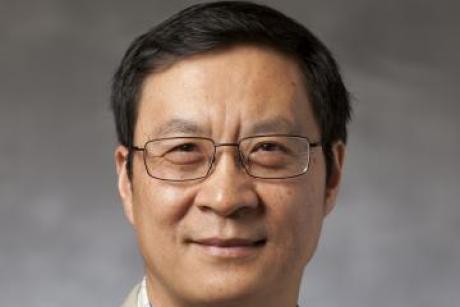Humans are changing the environment in many ways, and these changes have negative effects on our health. But the impacts are often largest among communities that already suffer from poverty and racial discrimination.
Four experts from the Duke Global Health Institute and the Nicholas School of the Environment explored current research on the communities that experience disproportionate effects from environmental problems such as water contamination and air pollution. The event, which took place on Thursday, Nov. 5, was part of the Duke Global Health Institute’s Think Global webinar series.
Watch the webinar below, or scroll down to read highlights from the conversation.
Watch DGHI's Think Global webinar, ...
Melissa Scott, postdoctoral associate at the Samuel duBois Cook Center on Social Equity
On the effect of systemic racism in environmental health disparities:
“Systemic racism is very deeply connected to environmental racism. … There’s a long history in the United States of redlining, of racial segregation in neighborhoods, of gentrification and displacement of people, as well as unequal urban design and a lack of capital and financing in some neighborhoods. Where people live is really a powerful predictor of health.”
On research showing disproportionate health effects on Black Americans due to air pollution:
“Not only did it show that Black Americans are experiencing some of the worst impacts due to air pollution, but that white Americans are actually causing a lot of the air pollution, raising big red flags in the idea of racial justice.”
On work by her mentor, Keisha Bentley-Edwards:
“She points out that there is this really important need for students, scholars, researchers and faculty to move beyond the acknowledgement that health disparities do in fact exist toward understanding the root causes of health outcomes, both positive and negative.”
On the importance of local action in the face of global change:
“Policy takes a while to reflect morality. In the context of local, global and national policies regarding air pollution, climate change and the built environment, we shouldn’t always wait for policy to enforce laws, but do so at the community level. What we can do together at the individual and community level is really important.”
Avner Vengosh, professor of earth and ocean sciences at the Nicholas School of the Environment and DGHI
On the environmental threat of lack of access to clean water:
“We are facing global water scarcity. Systematic water scarcity is growing. It’s almost everywhere across the world.”
On water usage to generate energy:
:This is becoming a major issue. Every time we turn on the light or use a computer we are using a huge amount of water (to generate electricity), specifically in North Carolina because we are depending on coal. The water-energy nexus is something that really affects water availability and water quality.”
On the “silent pandemic” of exposure to naturally occurring contaminants such as arsenic, fluoride, uranmium and chromium in drinking water:
“Many naturally occurring contaminants (in groundwater) have a severe impact on human health. Those contaminants – you cannot smell it or feel it, and the impact is long-term. So you don’t know you ae being poisoned by those contaminants. That’s why we call it the silent pandemic.”
On the impact of water contamination on rural communities:
“When we are focusing on North Carolina, which is similar to many parts of the world, the rural communities are the ones that are exposed to naturally occurring contaminants. In the city, the water is coming from surface water that has much more protection through treatment. … It’s a large worldwide population, mostly in rural and poor communities, that are exposed to these contaminants.”
William Pan, associate professor pf population studies and global environmental health
On how illegal logging contributes to deforestation in Peru, where he leads a research program:
“Seventy-five percent of the timber exports that leave Peru are from illegally logged areas. And almost all of that export comes to the United States, where they are used for furniture, decks, housing, etc. So when we think about these environmental issues, we also need to think about what’s driving those demands for natural resources.”
On the effect of gold mining in regions of Peru that are home to indigenous populations:
“The problem with gold mining is not just deforestation; it’s the fact that it’s also the leading cause of mercury pollution in the world. … When we look at indigenous communities, 77% of the indigenous have a mercury level that exceeds WHO thresholds. If this was happening in the United States, this would be a major emergency, and there would be resources put toward this immediately.”
On the health impacts of mercury exposure among indigenous communities:
We are seeing larger neurological effects from exposure. We’re seeing larger effects on anemia. We’re seeing larger effects on hypertension and kidney disease. … There have to be structural changes in Peru in order to address the fact that the indigenous are bearing the brunt of these kinds of environmental changes.”
Subhrendu Pattanayak, professor of environmental and energy policy
On research in Indonesia that showed clearing land for oil palm production using mechanical methods reduced health impacts from burning land:
“Oil palm producers have no incentive, none at all, to use a more expensive way to clear the land. … So you have to think through the implications of identifying the problem.”
On the challenge of adopting policies that balance environmental and commercial interests:
“Implementation seems to be the Achilles heel, because to go from concept to bringing policies on the ground is challenging. But that implementation shouldn’t be something that politicians have to work out. Implementation itself is a science, and there is work that can be done around that.”
“We should think about what kind of policies have to be brought to bear to deal with this challenge of environmental degradation. The exposure is coming from outside of the health sphere. All kinds of actors are out there, and they have all kinds of reasons. But they are reasons, and we have to figure out what those are for the exposure to change.”
On moving from “evidence-based practice” to “practice-based evidence”:
“As scientists, we are precisely answering pointless questions a lot of the time. I would much rater, in a way, get rough answers to the right questions. Build the evidence base around what people are already trying to do on the ground, which involves going to the communities and doing research around what they are actually doing. It may not be perfect, it may not be publishable in the top journals, but it is data that they need to get some sense about going right or left. … We have important problems to solve right now."


